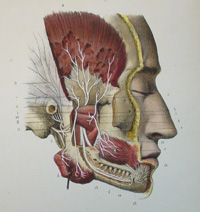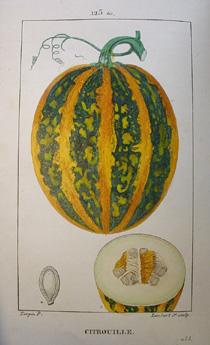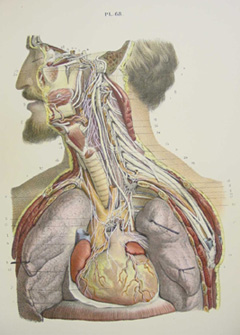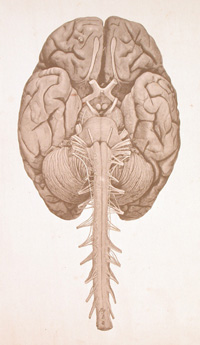Monuments of Medicine Collection
 |
| The nervous system of the face from Ludovic Hirschfeld’s Traité iconographique du système nerveux, 1866. |
The Monuments of Medicine Collection comprises medical literature published after 1820. It reflects both the unfolding of mass book production and the fundamental advances of 19th and early 20th century American and European medicine. Mass book production was fast, employed inexpensive materials, and resulted in high number of copies. Hence, in Monuments of Medicine frequently there are several editions of a particular book (showing development of a work) and the volumes are mostly in weak physical condition (showing frequent use). However, the collection is most vigorous in its content – representing radically new ideas, techniques, and instruments, new medical disciplines, fascinating discoveries and ardent debates. This is Becker Library’s most heavily used rare book collection. It provides resources primarily from the most energetic time period of history of medicine writing, the 19th century, offering most of the material in the English language.
Due to the immense volume of medical publishing in the post-1820 era, it is impossible to collect in all areas of modern medicine in a library the size of Becker. Thus, we generally collect literature in research and clinical disciplines in which the Medical School and its affiliated hospitals have traditionally played, and presently play, a leading role. These specialties include: gross anatomy, neurology, psychiatry, ophthalmology, surgery, otolaryngology, obstetrics and gynecology, and biomedical sciences. These fields of medicine constitute the strengths of the Monuments Collection as well.
Francois Pierre Chaumeton (1775-1819), Jean Louis Marie Poiret (1775-1834), Jean B. J. A. C. Chamberet de Tyribas (1775-1840). Flore medicale. Paris: C. L. F. Panckoucke, 1831-33. (No. 123) Hand-colored copperplate.
This illustration of Citrouille or pumpkin is taken from Chaumeton’s Flore medicale. This medical herbarium is one of the most exquisite botanical works of the early 19th century. It contains 349 delicately hand-colored engravings. Flore medicale provides variant names followed by the description of the plant and its “virtues” or medicinal use. The pumpkin’s medicinal use is described as follows: “The seeds [of the pumpkin] cure wounds, burning of the lungs . . . and hectic fever. From the seeds milk-water is made and the peel, chopped up to small pieces and cooked in oil, is laid on wounds [as an ointment]. The pumpkin quenches thirst, helps passing urine and stool, diminishes [the production] of male ‘seeds,’ and tames ‘Venus lust.’ ”
Jacques Pierre Maygrier (1771-1835). Midwifery illustrated. New York: Harper & Bros., 1834. (Plate 34) Lithography.
Jacques Pierre Maygrier studied anatomy in Paris under the accoucheur Antoine Dubois (1756-1837), successor to Baudelocque at the Hopitâl Maternité. Maygrier specialized in obstetrics and interned at the Hopital Cochin and the Hotel Dieu. Since the Faculté de médecine opened its obstetrical clinic only in 1840, the private instruction in midwifery Maygrier provided for several years in Paris was essential for the developing of the modern theory and practice of obstetrics in France. His books are comprehensive studies and at the same time practical guides for state of the art obstetrics of the early 19th century. They discuss phases of childbirth, pelvic deformities, pelvimetry, cesarean section, the use of the forceps, and even lactation.
The original French edition of Midwifery illustrated was published in 1822-27 under the title Nouvelles démonstrations d’accouchemens. It was a large folio size volume and contained a series of 80 large engravings. In the subsequent German and English editions the plates were recreated with the more modern lithographic method and these volumes are smaller in size.
Wooster Beach (1794-1868). An improved system of midwifery adapted to the reformed practice of medicine; illustrated by numerous plates. To which is annexed, a compendium of the treatment of female and infantile diseases, with remarks on physiological and moral elevation. New York: Jas. McAlister, 1847. (Frontispiece) Hand-colored lithography.
Wooster Beach is credited as the founder of eclectic medicine. He studied medicine with a country doctor in New Jersey before graduating from the medical college of New York University. He was in opposition to the heroic medicine of the early 19th century, which relied on treatments such as bloodletting, purgatives, and addictive opiates; he drew his ideas from the Thomsonians – followers of Samuel Thomson (1769-1843) – and other practitioners of botanical medicine. Since Beach developed the principles of his medical practice from different sources, he decided to call himself an eclectic.
Beach published a newsletter and wrote a number of books to publicize his views. In this volume Beach not only covers pregnancy, childbirth, and the diseases of women and children, but also includes remarks on the physiological and moral elevation of mankind. Beach’s “Summary Rules for Mothers” prescribes:
Study and obey the laws which regulate health.
Maintain a serene mind and an even unruffled temper.
Regard child-bearing as a natural and not a diseased condition, and dismiss an unnecessary and hurtful dread of it.
Suspend all the severer cares of life, and avoid the causes of extraordinary excitement, danger, and alarm.
Live on nourishing, but simple and moderate diet, with few or no stimulants.
Take regular and gentle exercise every day in the open air.
Continue, as far as possible, the ordinary occupations of life.
Endeavor to repress any tendency to nervous excitement.
John C. Gunn (ca. 1795-1863). Gunn’s New domestic physician or, home book of health; a guide for families, pointing out in familiar language, free from medical terms, the latest approved methods of treating the diseases of men, women and children, and for using the best new remedies, including medicinal plants. Cincinnati: Moore, Wilstach, Keys, 1858. (Plate following page 126) Hand-colored copperplate.
Gunn published the first edition of his Domestic Medicine, or Poor Man’s Friend in 1830. The publisher claimed that over 100,000 copies were sold. In this revised and expanded edition of 1858, Gunn admonished his readers that “health and happiness can never exist where temperance is not, and where piety is not a frequent visitor. There is no solace or balm against the cares, disappointments, and vicissitudes of life. All that is bright in the hope of youth, all that is calm and blissful in the meridian of life, all that is soothing in the vale of years, are derived from temperance and religion. The first wards off disease, the second calms and tranquilizes the mind under every affliction.”
Julien Fau. Atlas de l’anatomie des formes du corps humain : a l’usage de peintres et des sculpteurs. Paris, 1866. (Plate 25) Hand-colored lithography.
Although little is known about Julien Fau’s life, his published works highlight his various talents. As a medical doctor, he created three different artistic anatomies, which appeared in more than ten French, English and Dutch editions. This atlas of his was intended specifically for the use of painters and sculptors. His models often follow classic examples. This male figure showing the muscles of the human body is a copy of the ancient Greek statue of Laocoon. Fau’s interests also included surprisingly modern areas, such as photography: he wrote on the collodion process as early as 1854.
Ludovic Hirschfeld (1816-1876). Névrologie et esthésiologie: traité et iconographie du système nerveux et des organes des sens de l’homme avec leur mode de préparation. Paris: V. Masson, 1866. (Plate 68) Chromolithography.
This elaborately illustrated second edition was the standard textbook of neuroanatomy in its day, and the first work of its kind published in France.
Nicolaus Rüdinger (1832-1898). Atlas des peripherischen Nervensystems des menschlichen Körpers. Stuttgart: J. G. Cotta, 1872. (Fig. 1) Early photograph.
This illustration is an example of the early use of photography in medical illustration.
Rüdiger was an anatomy student of Jakob Henle (1809-1885) and Theodor Bischoff (1807-1882) in Heidelberg and Giessen. Later he became prosector to Bischoff and then Professor of Anatomy in München. In his books, he employed the early processes of photography. Bischoff, who wrote the preface to this atlas, expressed great enthusiasm about the use of the new illustration technique in anatomical works.
| Back to Top | © 2007-9 Washington University School of Medicine, St. Louis, Missouri |







